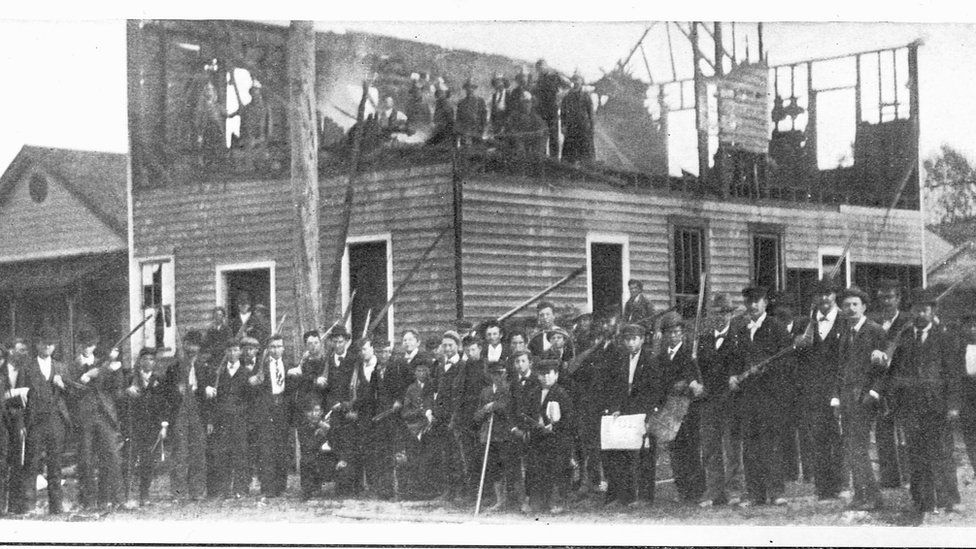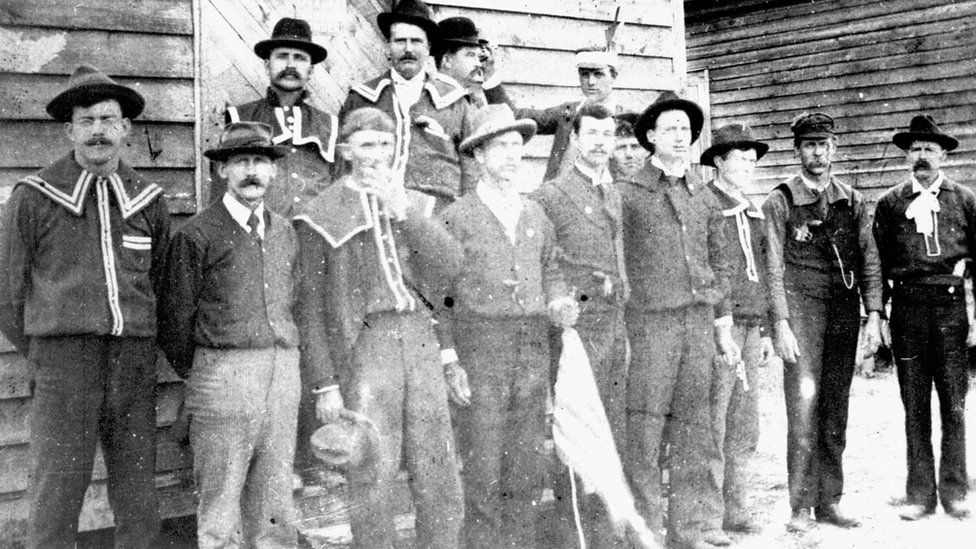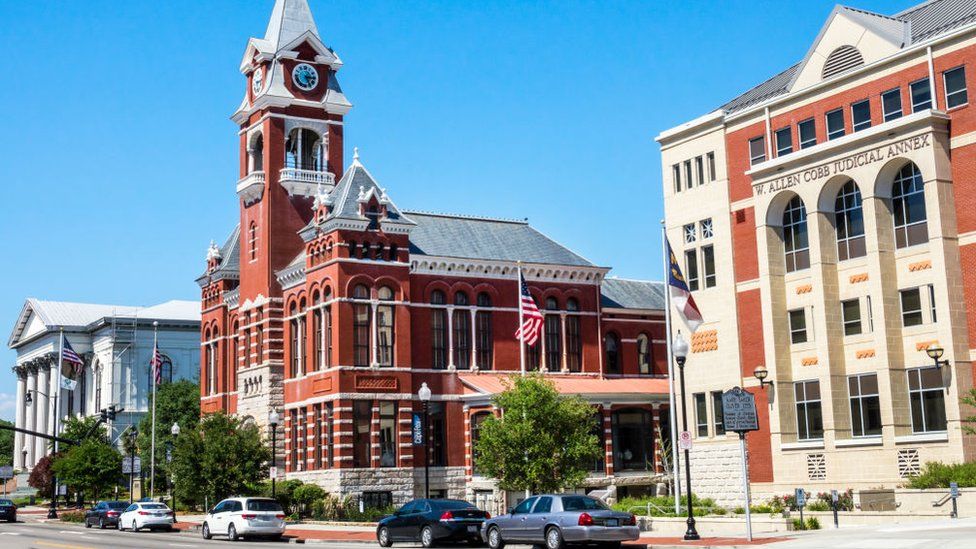Wilmington 1898: When white supremacists overthrew a US government
By Toby Luckhurst
BBC News
- Published
 image copyrightGetty Images
image copyrightGetty ImagesA violent mob, whipped into a frenzy by politicians, tearing apart a town to overthrow the elected government.
Following state elections in 1898, white supremacists moved into the US port of Wilmington, North Carolina, then the largest city in the state. They destroyed black-owned businesses, murdered black residents, and forced the elected local government - a coalition of white and black politicians - to resign en masse.
Historians have described it as the only coup in US history. Its ringleaders took power the same day as the insurrection and swiftly brought in laws to strip voting and civil rights from the state's black population. They faced no consequences.
Wilmington's story has been thrust into the spotlight after a violent mob assaulted the US Capitol on 6 January, seeking to stop the certification of November's presidential election result. More than 120 years after its insurrection, the city is still grappling with its violent past.

After the end of the US Civil War in 1865 - which pitted the northern Unionist states against the southern Confederacy - slavery was abolished throughout the newly-reunified country. Politicians in Washington DC passed a number of constitutional amendments granting freedom and rights to former slaves, and sent the army to enforce their policies.
But many southerners resented these changes. In the decades that followed the civil war there were growing efforts to reverse many of the efforts aimed at integrating the freed black population into society.
Wilmington in 1898 was a large and prosperous port, with a growing and successful black middle class. Undoubtedly, African Americans still faced daily prejudice and discrimination - banks for instance would refuse to lend to black people or would impose punishing interest rates. But in the 30 years after the civil war, African Americans in former Confederate states like North Carolina were slowly setting up businesses, buying homes, and exercising their freedom. Wilmington was even home to what was thought to be the only black daily newspaper in the country at that time, the Wilmington Daily Record.
"African Americans were becoming quite successful," Yale University history professor Glenda Gilmore told the BBC. "They were going to universities, had rising literacy rates, and had rising property ownership."
This growing success was true across the state of North Carolina, not just socially but politically. In the 1890s a black and white political coalition known as the Fusionists - which sought free education, debt relief, and equal rights for African Americans - won every state-wide office in 1896, including the governorship. By 1898 a mix of black and white Fusionist politicians had been elected to lead the local city government in Wilmington.
But this sparked a huge backlash, including from the Democratic Party. In the 1890s the Democrats and Republicans were very different to what they are today. Republicans - the party of President Abraham Lincoln - favoured racial integration after the US Civil War, and strong government from Washington DC to unify the states.
But Democrats were against many of the changes to the US. They openly demanded racial segregation and stronger rights for individual states. "Think of the Democratic party of 1898 as the party of white supremacy," LeRae Umfleet, state archivist and author of A Day of Blood, a book about the Wilmington insurrection, told the BBC.
Democratic politicians feared that the Fusionists - which included black Republicans as well as poor white farmers - would dominate the elections of 1898. Party leaders decided to launch an election campaign based explicitly on white supremacy, and to use everything in their power to defeat the Fusionists. "It was a concerted, co-ordinated effort to use the newspapers, speechmakers and intimidation tactics to make sure the white supremacy platform won election in November 1898," Ms Umfleet said.
White militias - including a group known as the Red Shirts, so named for their uniforms - rode around on horseback attacking black people and intimidating would-be voters. When black people in Wilmington tried to buy guns to protect their property, they were refused by white shopkeepers, who then kept a list of those who sought weapons and ammo.
 image copyrightCourtesy of the State Archives of North Carolina
image copyrightCourtesy of the State Archives of North CarolinaNewspapers meanwhile spread claims that African Americans wanted political power so they could sleep with white women, and made up lies about a rape epidemic. When Alexander Manly, owner and editor of the Wilmington Daily Record, published an editorial questioning the rape allegations and suggesting that white women slept with black men of their own free will, it enraged the Democratic party and made him the target of a hate campaign.
The day before the state-wide election in 1898, Democratic politician Alfred Moore Waddell gave a speech demanding that white men "do your duty" and look for black people voting.
And if you find one, he said, "tell him to leave the polls and if he refuses kill, shoot him down in his tracks. We shall win tomorrow if we have to do it with guns."
The Democratic party swept to victory in the state elections. Many voters were forced away from polling stations at gunpoint or refused to even try to vote, for fear of violence.
But the Fusionist politicians remained in power in Wilmington, with the municipal election not due until the next year. Two days after the state election Waddell and hundreds of white men, armed with rifles and a Gatling gun, rode into the town and set the Wilmington Daily Record building alight. They then spread through the town killing black people and destroying their businesses. The mob swelled with more white people as the day went on.
As black residents fled into the woods outside the town, Waddell and his band marched to the city hall and forced the resignation of the local government at gunpoint. Waddell was declared mayor that same afternoon.
"It [was] a full-blown rebellion, a full-blown insurrection against the state government and the local government," Prof Gilmore said.
 image copyrightGetty Images
image copyrightGetty ImagesWithin two years, white supremacists in North Carolina imposed new segregation laws and effectively stripped black people of the vote through a combination of literacy tests and poll taxes. The number of registered African American voters reportedly dropped from 125,000 in 1896 to about 6,000 in 1902.
"Black people in Wilmington didn't think that something like this would ever happen," Prof Gilmore said. "There was a Republican governor in the state, their congressman was a black man. They thought that things were actually getting better. But part of the lesson about it was as things got better, white people fought harder."
Deborah Dicks Maxwell is president of the local branch of the National Association for the Advancement of Colored People [NAACP] in Wilmington. Born and raised in the town, she didn't learn about the attack until she was in her thirties.
"It was something that those who are here [in Wilmington] knew but it was not widely talked about," she told the BBC. "It's not in the school curriculum like it should be - no one wants to admit this happened."
It was not until the 1990s that the city began to discuss its past. In 1998 local authorities commemorated the 100th anniversary of the attack, and two years later set up a commission to establish the facts. Since then the city has erected plaques at key points to commemorate the events, and has created the 1898 Monument and Memorial Park - something Ms Dicks Maxwell described as "small but significant".
Given what the city has gone through, it's no surprise that its residents and historians who have covered its past drew parallels between the 1898 insurrection and the attack on the US Capitol this month. Ms Dicks Maxwell and her NAACP branch had for months after the US election been highlighting what they saw as the similarities between what happened in Wilmington and how politicians today in the US were trying to undermine the election results.
"Earlier that day we had a press conference denouncing our local congressman for supporting Trump, [saying] that there would be a possible coup and that we did not want another coup to ever occur in this country," she said. Just hours later the mob marched on the US Capitol.
Christopher Everett is a documentary maker who made a film about the 1898 insurrection, Wilmington on Fire. When Mr Everett saw the attack on the Capitol he thought of Wilmington.
"No one was held accountable for the 1898 insurrection. Therefore it opened up the floodgates, especially in the south, for them to... strip African Americans' civil rights," he told the BBC. "That's the first thing that came to my mind after the DC insurrection - you're opening the door for something else to happen, or even worse."
The 1898 attack was not covered up. University buildings, schools and public buildings throughout the state were all named after the instigators of the insurrection. Men would later claim to have taken part in the attack to boost their stature in the Democratic Party. As the decades passed, history books started to claim the attack was in fact a race riot started by the black population and put down by white citizens.
"Even after the massacre, a lot of these folks who participated in and orchestrated the insurrection became immortalised - statues, buildings named after them, throughout the country, especially in North Carolina," Mr Everett said.
Charles Aycock - one of the organisers of the white supremacy electoral campaign - became governor of North Carolina in 1901. His statue now stands in the US Capitol, which rioters entered on 6 January.
Mr Everett is now filming a sequel to his documentary to examine how Wilmington is grappling with its past. He said many local leaders are working to "bring the city of Wilmington back to the spirit of 1897, when you had this Fusion movement of white folks and black folks working together and making Wilmington an example of what the new south could have been after the civil war."
"Wilmington was a model for the white supremacy movement with the insurrection," he said. "But now Wilmington could also be a model to show how we can work together and overcome the stain of white supremacy as well."
 image copyrightSpeller Street Films
image copyrightSpeller Street Films